 W
WArchery is the art, sport, practice, or skill of using a bow to shoot arrows. The word comes from the Latin arcus for bow. Historically, archery has been used for hunting and combat. In modern times, it is mainly a competitive sport and recreational activity. A person who participates in archery is typically called an archer or a bowman, and a person who is fond of or an expert at archery is sometimes called a toxophilite or a marksman.
 W
WFor non-archery Easton sports equipment, see Easton Diamond Sports.
 W
WThe archer's paradox is the phenomenon of an arrow traveling in the direction it is pointed at full draw, when it seems that the arrow would have to pass through the starting position it was in before being drawn, where it was pointed to the side of the target.
 W
WAn arrow is a fin-stabilized projectile launched by a bow. A typical arrow usually consists of a long, stiff, straight shaft with a weighty arrowhead attached to the front end, multiple fin-like stabilizers called fletchings mounted near the rear, and a slot at the rear end called nock for engaging the bowstring. A container or bag carrying additional arrows for convenient reloading is called a quiver.
 W
WAn arrowhead or point is the usually sharpened and hardened tip of an arrow, which contributes majority of the projectile mass and is responsible for impacting and penetrating an target, as well as to fulfill some special purpose such as signaling.
 W
WBear Archery is a manufacturer and marketer of bows and archery equipment located in Gainesville, Florida owned by Escalade Sports.
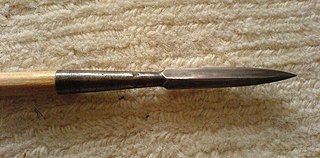 W
WA bodkin point is a type of arrowhead. In its simplest form it is an uncomplicated squared metal spike, and was used extensively during the Middle Ages. The typical bodkin was a square-section arrowhead, generally up to 11.5 cm (4.5 in) long and 1 cm (0.39 in) thick at its widest point, tapered down behind this initial "punch" shape. Bodkin arrows complemented traditional broadhead arrows, which continued to be used, as the sharp, wide cutting surface of the broadhead caused more serious wounds and tissue damage than the bodkin arrowhead.
 W
WBowfishing is a method of fishing that uses specialized archery equipment to shoot and retrieve fish. Fish are shot with a barbed arrow that is attached with special line to a reel mounted on the bow. Some freshwater species commonly hunted include common carp, grass carp, bighead carp, alligator gar, and bowfin. In saltwater, rays and sharks are regularly pursued.
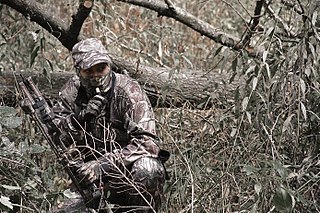 W
WBowhunting is the practice of hunting game animals by archery. Many indigenous peoples have employed the technique as their primary hunting method for thousands of years, and it has survived into contemporary use for sport and hunting.
 W
WA bowstring joins the two ends of the bow stave and launches the arrow. Desirable properties include light weight, strength, resistance to abrasion, and resistance to water. Mass has most effect at the center of the string; one gram (0.035 oz) of extra mass in the middle of the string slows the arrow about as much as 3.5 grams (0.12 oz) at the ends.
 W
WA bracer is a strap or sheath, commonly made of leather, stone or plastic, that covers the ventral (inside) surface of an archer's bow-holding arm. It protects the archer's forearm against injury by accidental whipping from the bowstring or the fletching of the arrow while shooting, and also prevents loose sleeve from catching the bowstring. They normally only cover part of the forearm, but full-length bracers extending to the upper arm are also available, and other areas have been covered by some archers. In addition, chest guards are sometimes worn, usually by female archers, to protect the breast. With some combinations of non-baggy clothing and bows with a larger distance between the bow and the string, the archer may not need to wear any bracer.
 W
WThe bullseye or bull's eye has, since 1833, been the name for the center of a target and, by extension, since 1857, has been given to any throw, toss, or shot that hits the center.
 W
WClout archery is a form of archery in which archers shoot arrows at a flag from a relatively long distance and score points depending on how close each arrow lands to the flag.
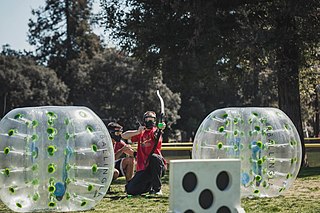 W
WCombat archery, sometimes known as battle archery is a sport similar to dodgeball, paintball or Nerf war played with bows and arrows tipped with foam.
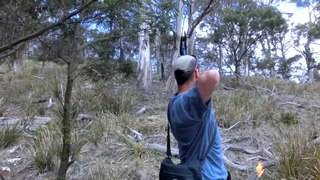 W
WField archery involves shooting at targets of varying and often unmarked distance, typically in woodland and rough terrain. As well as being a sport in its own right, it can be used to improve the techniques and abilities required for bowhunting in a realistic outdoor setting. Archers sometimes refer to the additional skills required to deal with challenging terrain and lighting as "fieldcraft".
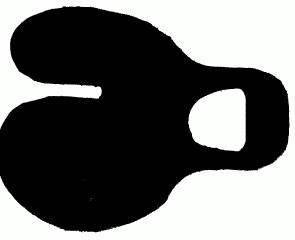 W
WIn archery, a finger tab or archer tab is a small leather or synthetic patch that protects an archer's fingers from the bowstring. It is strapped or otherwise attached to an archer's hand. In summertime, tabs are far more comfortable than gloves and can more conveniently use thicker material. They are also less expensive and easier to fit, and are the normal finger-protection used with bows.
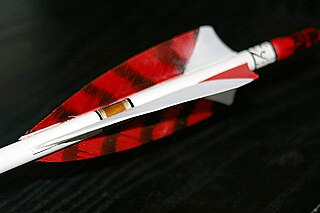 W
WFletching is the fin-shaped aerodynamic stabilization device attached on arrows, bolts, or darts, typically made from light, semi-flexible materials such as feathers or bark. Each piece of such fin is a fletch, also known as a flight or feather. A fletcher is a person who attaches fletchings to the shaft of arrows.
 W
WHercules the Archer is a sculpture by Antoine Bourdelle, originally made in 1909, which now exists in many versions. It was a commission of the financier and philanthropist Gabriel Thomas, as a single copy in gilt-bronze in April 1909; Bourdelle worked on the sculpture in the summer of 1909. It was cast by Eugène Rudier, and it was exhibited at the National Society of Fine Arts in 1910, and much appreciated. The dimensions were 2.50 m × 2.40 m.
 W
WThe Hoyt Ruckus is Hoyt's performance driven youth compound bow. It measures 29.3/4 inches axel to axel. It has a huge range of adjustability with draw lengths going from 18-28 inches at 1 inch increments. This bow can be bought at 10-40 or 20-50 pounds draw weight. The bow itself weighs 2.8 pounds. This bow can be used for hunting or target archery.
 W
WPooja Khanna is India's first ever Paralympic Archery player. She debuted at the 2016 Rio Olympics at the age of 25 and was the only archer from India among all the 19 athletes sent to the games. She secured a fifth-place in the final Paralympic Qualifier which secured India's spot in the 2016 Olympics under World Quota Recurve Women Open in the Czech Republic 2016. Her Olympic's journey ended at Round 32 after she failed to defeat Poland's Milena Olszewska by 2–6. She was able to secure a rank of 29 out of the 32 archers participating.
 W
WA horse archer is a cavalryman armed with a bow and able to shoot while riding from horseback. Archery has occasionally been used from the backs of other riding animals. In large open areas, it was a highly successful technique for hunting, for protecting the herds, and for war. It was a defining characteristic of the Eurasian nomads during antiquity and the medieval period, as well as the Iranian peoples, and Indians in antiquity, and by the Hungarians, Mongols, Chinese, and the Turkic peoples during the Middle Ages. By the expansion of these peoples, the practice also spread to Eastern Europe, Mesopotamia, and East Asia. In East Asia, horse archery came to be particularly honored in the samurai tradition of Japan, where horse archery is called Yabusame.
 W
WPara-archery classification is the classification system for para-archery used to create a level playing field for archers with a different range of disabilities. Governance in the sport is through the International Archery Federation. Early classification systems for the sport were created during the 1940s and based on medical classification. This has subsequently changed to a functional mobility classification with the exception of blind archery.
 W
WPopinjay or Papingo, also called pole archery, is a shooting sport that can be performed with either rifles or archery equipment. The object of popinjay is to knock artificial birds off their perches. The rifle form is a popular diversion in Denmark; a Scottish variant is also known. The archery form, called staande wip in Flemish language, is popular in Belgium and is shot occasionally in the United Kingdom under the governance of the Grand National Archery Society. In Germany a traditional shooting at wooden birds placed on a high pole is called "Vogelschießen". These are carried out either with small bore rifles or crossbows.
 W
WA quiver is a container for holding arrows, bolts, darts, or javelins. It can be carried on an archer's body, the bow, or the ground, depending on the type of shooting and the archer's personal preference. Quivers were traditionally made of leather, wood, furs, and other natural materials, but are now often made of metal or plastic.
 W
WRun archery is a shooting discipline connecting archery with running. It is similar to the sport of biathlon.
 W
WShooting targets are objects in various forms and shapes that are used for pistol, rifle, shotgun and other shooting sports, as well as in darts, target archery, crossbow shooting and other non-firearm related sports. The center is often called the bullseye. Targets can for instance be made of paper, "self healing" rubber or steel. There are also electronic targets that electronically can provide the shooter with precise feedback of the shot placement.
 W
WIn archery, a stabiliser is a general term for various types of weights, usually on rods, mounted on the bow to increase stability i.e. lessen movement on release, thereby increasing precision. Stabilisers help reduce inconsistencies of the archer's release by increasing the moment of inertia of the bow. If the shooting technique of the archer were perfect, no stabilisers would be required.
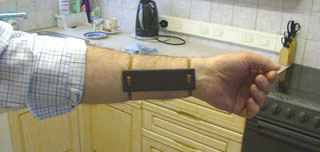 W
WEarly Bronze Age stone wrist-guards are found across Europe from around 2400-1900 BC and are closely associated with the Beaker culture and Unetice culture. In the past they have been variously known as stone bracers, stone arm-guards and armlets, although "stone wrist-guard" is currently the favoured terminology; and it's no longer thought that they were functional archer's bracers.
 W
WTarget archery is the most popular form of archery, in which members shoot at stationary circular targets at varying distances. All types of bow – longbow, barebow, recurve and compound – can be used. In Great Britain, imperial rounds, measured in yards, are still used for many tournaments and these have slightly different rules to metric (WA) rounds, which are used internationally. Archers are divided into seniors and juniors, with juniors being those under the age of 18.
 W
WA thumb ring is a piece of equipment designed to protect the thumb during archery. This is a ring of leather, stone, horn, wood, bone, antler, ivory, metal, ceramics, plastic, or glass which fits over the end of the thumb, coming to rest at the outer edge of the outer joint. Typically a flat area extends from the ring to protect the pad of the thumb from the bowstring; this may be supplemented by a leather extension.